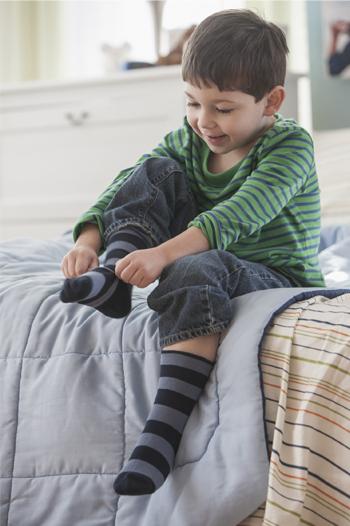Getting dressed
Duration/age

What will you wear today?
There are plenty of decisions to make when you help your child get dressed in the morning.
What are you doing today?
Does what you do change what you will wear? Is it a day at home or a going out day?
Today we are going to playgroup so you’ll need to wear clothes you can play in.
What is the weather like today?
You can find out by looking at the weather forecast or just looking out the window.
It will be cold outside so what will you need to wear - a jumper or a T-shirt?
What do you put on first when you get dressed?
First goes the underwear, then the outer wear. You can talk with your child about making sure the clothes are around the right way and not inside out or back-to-front.
First put your left leg into the jeans and then your right leg. Now put the top over your head . . . one arm in, the other arm in.
Show your child the difference between shoes and socks. It doesn’t matter which foot the socks go on but it does matter with shoes. Talk about why this is different.
Materials you will need
- Shoes
- Clothes
- Weather forecast
Skills this activity improves
Why does this matter?
Getting dressed helps your child to develop their motor skills as they put the clothes on and as they balance, stretch and reach.
When you are making decisions together about what to wear your child will be learning to sort and group like ‘some clothes are for warm days, some are for cold days’ or ’some clothing is for day time and some for night-time’.
As you encourage or help them get dressed they will be learning about sequencing - ‘first your socks, then your shoes’ - and following directions.
What does this lead to?
Motor skills help your child’s strength and coordination. Strong fine motor skills, like those your child will develop as they do up buttons, buckles or laces, help with writing as well. Big muscles, like those you develop when you put on pants or a jacket, help children move safely around their environment.
Sorting and grouping are important skills that we use every day when we make decisions, make plans or organise different parts of our lives.
Being able to sequence and follow directions are important life skills that help us with things like putting furniture together or following a recipe.
Language to use
- Cold, warm, hot
- Wet, dry
- Pyjamas, pants, tops
- Shirt, T-shirt, jumper
- Jeans, skirt
- Front, back, left, right
- Back-to-front, inside out
- First, next
Questions to use
- Would you like to wear the red socks or the blue socks today?
- Can you put your pants on by yourself?
- Who can get dressed first? You or me?
- Can you find your thick stockings in the drawer?
Useful tips
- You might also like to take a look at the activities Read my shirt and What is the weather today?
- Remember to talk to your child in your home language.
More ideas
- When you are doing the washing your child can help to sort their clothes for the wash. Afterwards they can help to put them away in the right place.
- Remember to talk to your child in your home language.
Variation by age
Three to five year olds
- Make or find some clothes for your child’s teddy or doll. They can get their teddy dressed for different events, like going to bed or playing outside.
Questions to ask
- What will Teddy wear today?
- Will that fit her?
- Will your doll’s clothes fit Teddy? What about yours?
Language to use
- Inside, outside
- Small, big, just right


